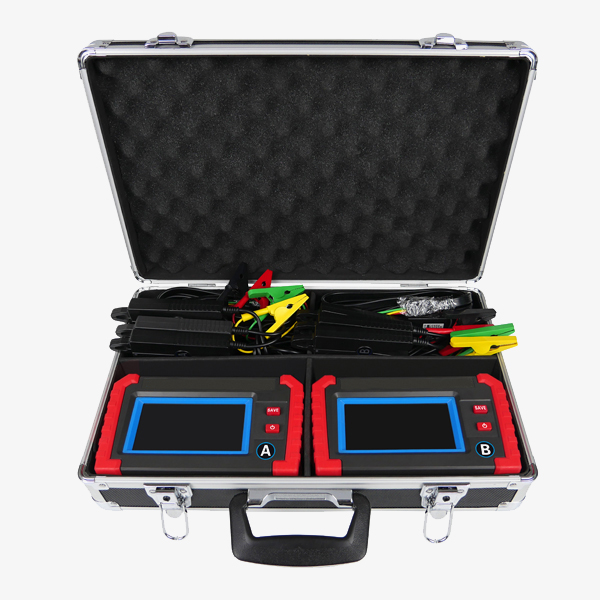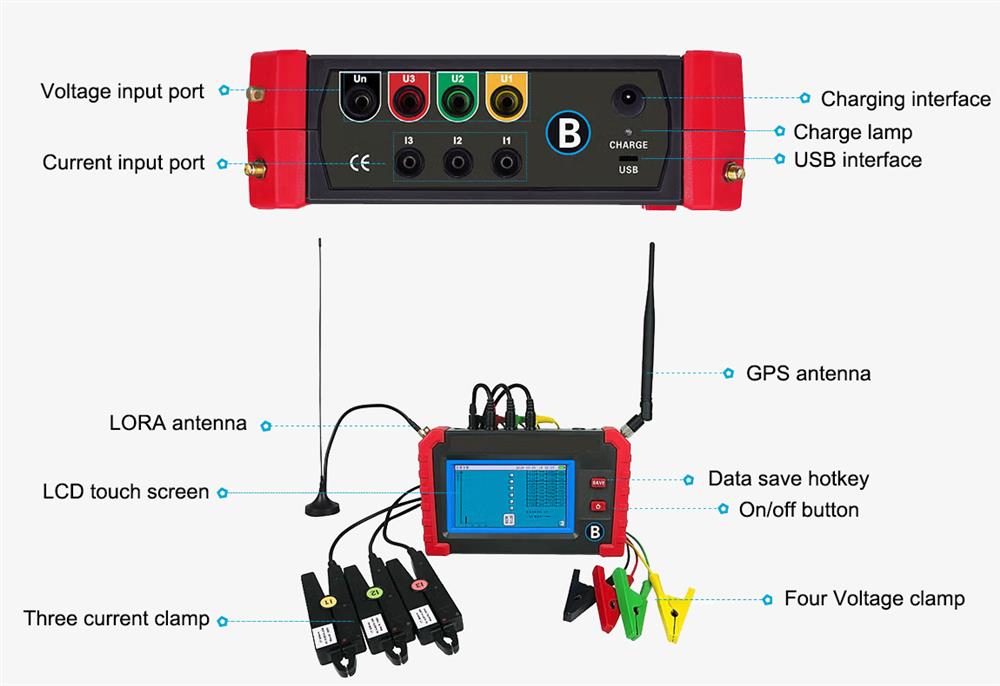3 phase digital volt amp meter, wireless, can perform wireless phase identification and test current, voltage, phase, etc. at different locations in the substation, with a 5-inch touch color screen, large-capacity rechargeable lithium battery, data storage and query, USB interface data upload and other functions. High precision volt-ampere meter has 2V~700V voltage range, 0.001A~20A current range and 0°~360° phase range, automatic measurement, simple and quick operation, accurate and reliable, widely used in electrical equipment manufacturing, petrochemical, iron metallurgy, railway Electrification, scientific research and teaching, etc.

3 Phase Volt Amp Meter, Wireless, Max. Current 20A, Max. Voltage 700V, Φ8mm CT size, USB interface for uploading the data.
- sisco 3 phase volt amp meter provides a variety of measurement modes, can be single-phase, two-phase and three-phase measurement mode, Three-phase 4-wire and three-phase 3-wire measurement mode.
- The measuring personnel only need the wiring operation, the voltammeter automatic measurement, and real-time update data, which is convenient for field analysis.
- The meter adopts complete isolation technology to avoid safety accidents.
- High precision multi 3 phase volt amp meter is available with a touch color screen, easy and convenient operation, large capacity lithium battery, USB interface, data upload function and so on.
Details
Applications
Wireless 3 phase digital volt amp meters can directly measure AC voltage, AC current, between two voltages, between two currents, and the phase between voltage and current and power frequency. sisco volt amp meters are suitable for electric power, petrochemical, metallurgy, railway, meteorology, industrial and mining enterprises, scientific research institutions, measurement departments, etc., especially for electric energy billing systems and relay protection systems.

| Model | SISCO-VAM-4480 |
| Power Supply | DC7.4V, 5200mAH rechargeable lithium battery |
| Communication Mode | Wireless LORA (230MHz) |
| Wireless Communication Distance | 1Km (in the open area) |
| Function Option | Touch screen option |
| Display Mode | 5 inch touch color screen |
| LCD Size | 108X65mm |
| Host Size | 210mmx129mmx68mm |
| Weight | Meter: 870g; Total weight: 4000g (with the package) |
| Test Line | Two of each yellow, green, red, and black voltage test line |
| Current Clamp | Clamp jaw size φ8mm (3pcs) |
| Data Storage | 1000 groups |
| Data Upload | USB interface, tester record data can be uploaded to computer, and can export the EXCEL format |
| Battery Voltage | Battery power indicator display, battery voltage lower than 10% remind to charge in time |
| Automatic Shutdown | 15 minutes after power on, will automatic shutdown without any operation. Before shutdown will reminder |
| Working Time | Continue working time is 12 hours when full charge. |
| Power Consumption | Working(backlight 50mA): 320mA |
| Working Condition | Temperature: -20~50℃; Relative humidity: 0~95%HR without condensation |
| Accessories | Handle terminal meter:2PCS; Current clamp sensor: 6PCS; Test line: 8PCS;Charger:2PCS; USB communication cable: 2PCS; Meter case:1PC |
Range and Accuracy
| Measurement Type | Measurement Range | Accuracy | Resolution |
| Voltage | 2V~700V | ±0.3%Fs | 0.0001V |
| Current | 0.001A-20A | ±0.3%Fs | 0.0001A |
| Phase | 0°~360° | ±1° | 0.1° |
| Frequency | 45Hz~65Hz | ±0.03Hz | 0.0001Hz |
| Harmonic | 2~21 times | - | - |
| Active Power | 0.002W~14000W | ±0.3%Fs | 0.0001W |
| Reactive Power | 0.002VAR~14000VAR | ±0.3%Fs | 0.0001VAR |
| Apparent power Range | 0.002VA~14000VA | ±0.3%Fs | 0.0001VAR |
| PT Secondary Admittance | 1.0mS~100mS | ±0.5%Fs | 0.0001mS |
| CT Secondary Impedance | 0.1Ω~50Ω | ±0.5%Fs | 0.0001Ω |
Wiring Methods

Q1: What is a volt amp meter?
A1: A digital volt amp meter is a high-precision, low-consumption, low-cost, portable, handheld, dual-channel input measuring instrument, specially designed for measuring voltage, current and phases on-site.
Q2: How a volt amp meter works?
A2: The volt-ampere meter adopts the clamp conversion method to input the measured current, so there is no need to disconnect the measured line during measurement. When measuring the phase between U1-U2, the two input circuits are completely insulated and isolated, thus completely avoiding the short circuit of the measured line caused by miswiring and burning the measuring instrument. This is the working principle of volt ammeters.
Q3: What can a volt amp meter do?
A3: When the circuit under test is not open, the volt ammeter can simultaneously measure two AC voltages, currents, phases between voltages, phases between currents, phases between voltages and currents, frequency, phase sequence, active power, reactive power, apparent power, power factor, etc., the volt amp meter can also identify the transformer wiring group, inductive and capacitive circuits, test the secondary circuit and bus differential protection system, read the phase relationship between the CTs of the differential protection groups, and check the watt-hour meter wiring and line equipment.
Tips: Phase relationship between voltage and current
The phase difference of voltage and current depends on the nature of the load, and the voltage and current of a purely resistive load are in phase. The current phase is a physical quantity that reflects the state of alternating current at any moment. The magnitude and direction of alternating current change with time. Phase voltmeters are used to measure the phase between voltage and current.
Thank you for buying industrial test and measurement equipment on SISCO.com, all products sold by SISCO and the partner cover a 12 months warranty, effective from the date of receiving the products.
What is covered?
SISCO is responsible for providing free spare parts, and free technical support to assist the customer to repair the defective products until the problem is solved.
What is not covered?
- Product purchased from anyone other than a SISCO store or a SISCO authorized reseller.
- Expendable parts.
- Routine cleaning or normal cosmetic and mechanical wear.
- Damage from misuse, abuse or neglect.
- Damage from use of parts other than SISCO approved.
- Damage from use outside the product’s usage or storage parameters.
- Damage from use of parts not sold by SISCO.
- Damage from modification or incorporation into other products.
- Damage from repair or replacement of warranted parts by a service provider other than a SISCO authorized service provider.
- Damage caused by the application environment not meeting the product usage requirements and the failure to perform preventive maintenance.

